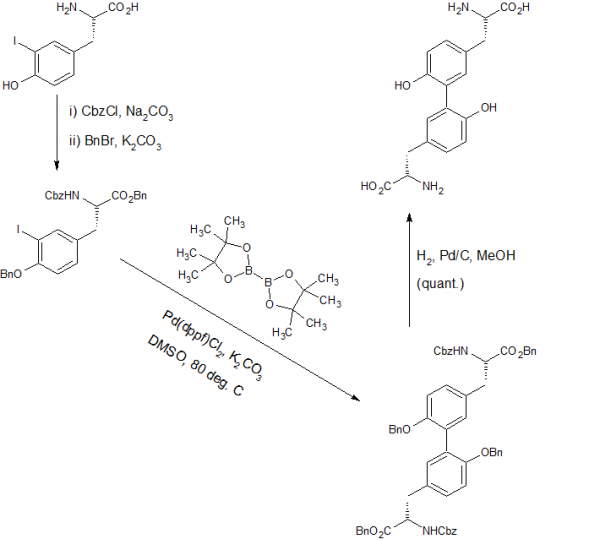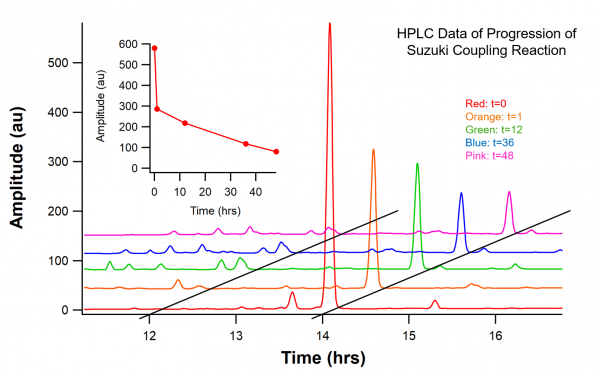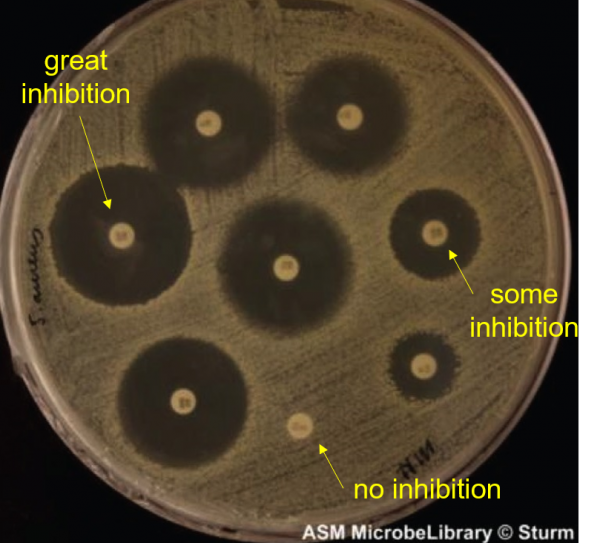Difference between revisions of "Investigating the Organic Synthesis of Dityrosine"
| Line 64: | Line 64: | ||
2. Dityrosine cross-linking in designing biomaterials | 2. Dityrosine cross-linking in designing biomaterials | ||
| − | + | :Benjamin P. Partlow, Matthew B. Applegate, Fiorenzo G. Omenetto, and David L. Kaplan, ACS Biomaterials Science & Engineering 2016 2 (12), 2 | |
108-2121, DOI: 10.1021/acsbiomaterials.6b00454 | 108-2121, DOI: 10.1021/acsbiomaterials.6b00454 | ||
Revision as of 17:24, 1 February 2021
You have reached the page dedicated to research investigating an efficient organic synthesis of the dityrosine molecule. This research is carried out by Monmouth College undergraduate Katelyn Richter under the supervision of Dr. Bradley Sturgeon.
Introduction
New interest in peptides and proteins containing cross-linked dityrosine residues is increasing due to fascinating biological properties they have. Dityrosine is the dimerized form of the amino acid L-tyrosine. Some examples of said biological properties include increased stabilization of structures, conformational restriction of cyclic peptides, and variation in the electronic properties seen in enzyme active sites.[1] The possibilities of application in biological systems make tyrosine dimers a molecule of great intrigue. Dityrosine cross-linking also has a plethora of applications in the realm of biomaterials that mimic cellular environments with great potential for developing ground-breaking techniques in regenerative medicine and tissue engineering.[2] Dityrosine research also provides great insight into the progression of Alzheimer’s disease, which can be defined as the aggregation of insoluble amyloid plaques in the neuropil composed of highly stable, self-assembled Amyloid-beta42 fibrils, the neurotoxic dimerization of which is a direct result of dityrosine cross-linking.[3] These are just a few examples of the vast number of applications dityrosine has, illustrating why it is certainly a molecule worth researching. However, dityrosine is quite expensive. Therefore, in order to test dityrosine and dityrosine derivatives for biological applications, it is much more financially feasible and good laboratory experience for undergraduate researchers to synthesize it themselves.
Project Goals
1. Synthesize dityrosine.
In order to study dityrosine, it is necessary to synthesize it rather than buy it. Dityrosine is only available to buy as a standard, and even the smallest quantities of it are quite expensive. You can’t even buy dityrosine from Sigma Aldrich. A 5mg standard from AdooQ costs $149.00. For the Sturgeon group's intents and purposes, a larger amount of this compound is needed.
2. Apply dityrosine synthesis pathway to synthesis of dityrosine derivatives.
Once the organic synthesis of dityrosine has been optimized, it can be applied to the synthesis of dityrosine derivatives. Some of these analogs could be made by simply brominating or chlorinating an aromatic ring, the addition of a nitro group, etc.
3. Test dityrosine and derivatives for biological properties via Kirby-Bauer Disk Diffusion Assay.
Once the molecules of interest have been synthesized and purified, they will be tested for various biological properties, such as antifungal and antibacterial properties, in the hopes that some of the analogs will show some significant or interesting biological activity.
Synthesis
Below is the proposed synthesis for dityrosine[4]:
The starting molecule is 3-iodo-L-tyrosine. This compound is reacted first with benzyl chloroformate and sodium carbonate followed by benzyl bromide and potassium carbonate. This step adds three protecting groups to the molecule. After the protecting groups have been added, this protected intermediate undergoes a Suzuki coupling reaction, which creates a bond between the two aromatic rings. This is accomplished using the suzuki reagent, bis-pinacolato diboron. Once the coupling is complete, the molecule is deprotected using palladium on charcoal and hydrogen, yielding the final molecule of dityrosine. Chromatography is done in between each step to purify intermediates and the final product.
Chromatography
Each intermediate was purified via column chromatography prior to the next reaction. This is done in reverse phase. The first and second intermediates were purified via gradient of EtOAc/hexanes (1:9 - 9:1). The final product has not yet been synthesized, but it will be purified with ether/DCM/hexanes (1:2:3 - 1:2:2 gradient).
Data
Thin Layer Chromatography (TLC) is typically the preferred method for mediating the progression of organic reactions. However, there is also opportunity to utilize High Performance Liquid Chromatography (HPLC) as well to observe the disappearance of reactants and the formation of products. HPLC was used to observe the Suzuki coupling reaction which forms the protected dityrosine intermediate. To prepare samples, an aliquot (three drops) of the reaction was added to a sample vial and brought to a volume of 1 mL with methanol with methanol. This was done five times as the reaction progressed at the initiation of the reaction, 1 hour, 12 hours, 36 hours, and 48 hours. As the reaction continued, the reactant peak (observed at 14 minutes) decreased. This can also be observed in this smaller red graph in the upper left corner. Various products also formed in small amounts (observed between 2 and 12 minutes). However, there does not appear to be one major product based on these spectra alone. This is because the protected dityrosine intermediate was insoluble in the reaction mixture. As a result, it was left at the bottom of the flask rather than being drawn up with sample aliquots taken for analysis. After aqueous extraction and concentration under vacuo of the reaction, the major product was a viscous brown oil.
Current Work and Future Plans
The synthesis has been completed up to the Suzuki coupling reaction. The protected dityrosine intermediate is the most recent intermediate that has been synthesized. Future work on this project includes the purification of the protected dityrosine intermediate via column chromatography, as well as the deprotection of this intermediate to obtain the final product of dityrosine. The final dityrosine product will also be purified via column chromatography.
Following the synthesis of dityrosine, the molecule will be tested for antibacterial properties against a nonvirulent strain of E. coli via Kirby-Bauer Disk Diffusion assay. Analogs of dityrosine will also be synthesized and tested for antibacterial properties to investigate whether derivatized forms of dityrosine have possible medicinal applications.
Kirby-Bauer Disk Diffusion Assay
The Kirby Bauer Disk Diffusion Assay is a common, reliable, and simple technique for examining antimicrobial properties of potential drugs.[5] It is a sensitive, convenient and inexpensive method of screening.[6] Kirby Bauer Disk Diffusion assays will be carried out using a nonvirulent strain of E. coli on glucose minimal media plates. The plates are completely coated with the bacteria and disks containing compounds of interest will be placed onto the plate. After the bacteria’s incubation period, the zones of inhibition surrounding each disk containing the compound of interest will be recorded. The larger the zone of inhibition, the more effective the compound is as an antibiotic. This test can also be performed with fungi.[7]
References
1. Synthesis of the side chain cross-linked tyrosine oligomers dityrosine, trityrosine, and pulcherosine
Ojia Skaff, Katrina A. Jolliffe, and Craig A. Hutton, The Journal of Organic Chemistry 2005 70 (18), 7353-7363, DOI: 10.1021/jo051076m
2. Dityrosine cross-linking in designing biomaterials
- Benjamin P. Partlow, Matthew B. Applegate, Fiorenzo G. Omenetto, and David L. Kaplan, ACS Biomaterials Science & Engineering 2016 2 (12), 2
108-2121, DOI: 10.1021/acsbiomaterials.6b00454
3. A central role for dityrosine crosslinking of Amyloid-β in Alzheimer’s disease
Youssra K. Al-Hilaly et al., PubMed 2013, DOI: 10.1186/2051-5960-1-83
4. Synthesis of the side chain cross-linked tyrosine oligomers dityrosine, trityrosine, and pulcherosine
Ojia Skaff, Katrina A. Jolliffe, and Craig A. Hutton, The Journal of Organic Chemistry 2005 70 (18), 7353-7363, DOI: 10.1021/jo051076m
5. Reliability of the Kirby-Bauer Disc Diffusion Method for Detecting Methicillin-Resistant Strains of Staphylococcus aureus, W. Lawrence Drew,
A. L. Barry, Richard O'Toole, John C. Sherris, Applied Microbiology Aug 1972, 24 (2) 240-247
6. P L Ho, K H Chow, K Y Yuen, W S Ng, P Y Chau, Comparison of a novel, inhibitor-potentiated disc-diffusion test with other methods for the
detection of extended-spectrum beta-lactamases in Escherichia coli and Klebsiella pneumoniae., Journal of Antimicrobial Chemotherapy, Volume 42, Issue 1, Jul 1998, Pages 49–54, https://doi.org/10.1093/jac/42.1.49
7. M.C. Manganyi, T. Regnier, A. Kumar, C.C. Bezuidenhout, C.N. Ateba,
Biodiversity and antibacterial screening of endophytic fungi isolated from Pelargonium sidoides, South African Journal of Botany, 2018, 192-199, ISSN 0254-6299, https://doi.org/10.1016/j.sajb.2018.03.016.


